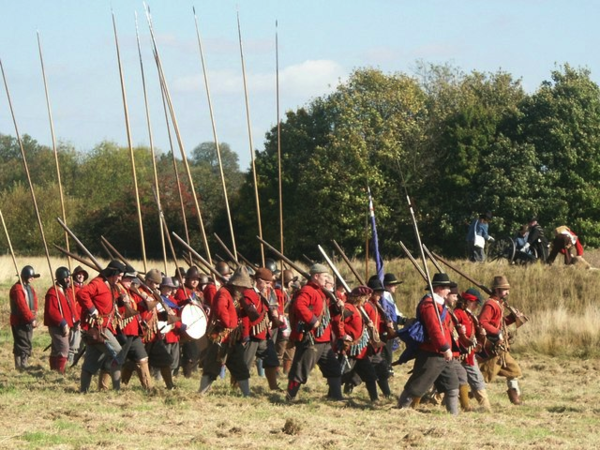The English Civil War
The English Civil War erupted in 1642. In January 1942, King Charles I tried to arrest five of his chief detractors in the Houses of Parliament. The men escaped and the king’s actions horrified much of the English public. Slowly the country began to splinter into two rival sides: the Parliamentarians and the Royalists, or (as they pejoratively called each other), the ‘Roundheads’ and the ‘Cavaliers’. The start of the war is normally dated the 22 August 1642: the day that Charles I raised his royal standard at Nottingham.
Like most wars in the 17th century, the English Civil War was more of a series of intermittent battles and skirmishes than one continuous war - 17th century armies lacked mobility and needed lots of time to collect even very basic equipment. The weather was also important in determining whether armies could fight. Harsh winters often cut up roads and rendered them beyond use. This could scupper an army’s progress.
It is difficult to give an exact breakdown of either side’s support, but it tended to be that the nobility and landowners supported Charles I, as did the Anglicans. Meanwhile those who lived in towns and cities tended to support Parliament. This is only a broad-brush generalisation: naturally there were people within each of these categories actually supported the other side.

The three most significant battles during the English Civil War took place at Edgehill in 1642, Marston Moor in 1644 and Naseby in 1645.
The battle of Edgehill ended indecisively with both sides claiming victory. Over the next 12 months, there was series of smaller battles but neither side could land a fatal blow on its opposition.
In 1644, the English Parliamentarians and Scottish Covenanters heavily defeated Charles I at the Battle of Marston Moor. Charles lost control of the north of England.
In June 1645, Sir Thomas Fairfax and Oliver Cromwell led the New Model Army to a decisive victory at the Battle of Naseby. This dealt a fatal blow to the king’s army.
In 1646, Charles decided that he would surrender to the instead of to Parliament. The Scottish -Parliamentary alliance was a fragile one, and Charles hoped it might collapse. This actually backfired and in January 1647 the Scots took Charles to Parliament and sold him to them for £400,000. In November 1647, he escaped to Hampton Court. He was re-imprisoned by the Parliamentary Governor of the Isle of Wight at Carisbrooke Castle, but was able to negotiate with the Scots from captivity. They came to a deal: if the Scots restored Charles to the throne, he would impose Presbyterianism in England for three years. In May 1648 the Second Civil War broke out and the Scots invaded. However, in August they were resounding defeated at the Battle of Preston. This put an end to their plans to restore the monarchy. Negotiations between Charles and Parliament began in September.
Oliver Cromwell and his army henchman were vehemently opposed to negotiating with Charles. However, in December 1648, Parliament voted to continue negotiations with the king. The army decided to get their way by force. Pride’s Purge took place from 6 to 7 December. Any MPs who disagreed with the military were imprisoned or intimidated so that they would not attend Parliament. The army could then force through an act of parliament to try the king for treason in January.
In January 1649 Charles went on trial at Westminster Hall it was ruled that he had “traitorously and maliciously levied war against the present Parliament and the people therein represented”. He was found guilty of treason and - in the only ever case of a British monarch being put to death - he was executed at Whitehall on 30 January 1649.
See also:
The Causes of the English Civil War
Causes of the English Civil War -Timeline
MLA Citation/Reference
"The English Civil War". HistoryLearning.com. 2026. Web.
